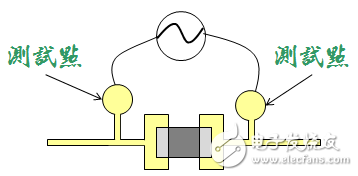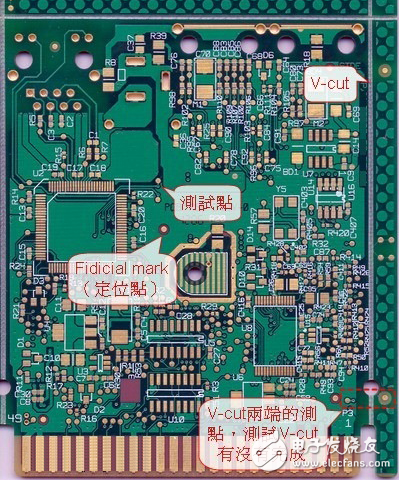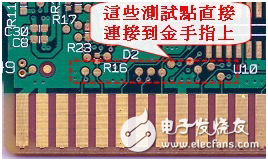For those who learn electronics, it is natural to set test points on the board, but what about test points for those who learn machinery? Basically, the purpose of setting test points is to test whether the components on the board meet the specifications and solderability. For example, if you want to check the resistance of a board, there is no problem. The easiest way is to take the meter. You can know by measuring both ends. However, in mass-produced factories, there is no way for you to use the meter to slowly measure the correctness of each resistor, capacitor, inductor, or even IC circuit on each board, so there is a so-called ICT ( In-Circuit-Test) The emergence of an automated test machine that uses multiple probes (generally referred to as "Bed-Of-Nails" fixtures) to simultaneously touch all of the parts on the board that need to be measured. Then, through program control, the sequence is used as the main method, and the side-by-side method is used to measure the characteristics of these electronic parts. Usually, it takes only 1~2 minutes to test all the parts of the general board, depending on the number of parts on the circuit board. The more parts, the longer it takes. However, if these probes are directly exposed to the electronic components on the board or their solder joints, it is likely to crush some electronic components, but it is counterproductive, so the clever engineers invented the "test points" at both ends of the parts. An additional pair of small dots are placed with no mask on them, allowing the test probe to touch these small points without directly touching the electronic components being measured. In the early days when the board was also in the traditional plug-in (DIP) era, the soldering feet of the parts were used as test points. Because the soldering feet of the traditional parts are strong enough, they are not afraid of pinning, but there are often probes. The misjudgment of poor contact occurs because the general electronic parts after wave soldering or SMT eat tin, a residual film of solder paste is usually formed on the surface of the solder. The impedance of this film Very high, often caused by poor contact of the probe, so the test workers who often see the production line at that time, often with an air spray gun desperately blowing, or alcohol to wipe these areas to be tested. In fact, the test points after wave soldering will also have poor probe contact. Later, after SMT became popular, the test misjudgment situation was greatly improved. The application of test points was also greatly entrusted because SMT parts are usually very fragile and cannot withstand the direct contact pressure of test probes. It is possible to prevent the probe from directly contacting the part and its soldering foot, not only to protect the part from damage, but also to greatly improve the reliability of the test, because the situation of misjudgment is reduced. However, with the evolution of technology, the size of the circuit board is getting smaller and smaller. It is already a little difficult to squeeze so many electronic parts on the small circuit board, so the test points occupy the space of the board, often in the There is a tug-of-war between the design side and the manufacturing end, but this issue will have a chance to talk again later. The appearance of the test points is usually round, because the probes are also round, better to produce, and it is easier to get adjacent probes closer together, so that the needle density of the needle bed can be increased. 1. The use of a needle bed for circuit testing has some inherent limitations on the mechanism. For example, the minimum diameter of the probe has a certain limit, and the needle of too small diameter is easily broken and damaged. 2. There is also a limit to the distance between the needles, because each needle has to come out of one hole, and a flat cable is welded to the back end of each needle. If the adjacent holes are too small, except for the needle and needle. There is a problem of contact short circuit, and the interference of the flat cable is also a big problem. 3. No needles can be implanted next to some high parts. If the probe is too close to the high part, there is a risk of damage caused by colliding with the high part. In addition, because the part is high, it is usually necessary to open the hole in the test fixture needle bed seat, and indirectly cause the needle to be implanted. Test points on all parts of the board that are getting harder to accommodate on the board. 4. As the board gets smaller and smaller, the number of test points is often discussed. Now there are some ways to reduce the test points, such as Net test, Test Jet, Boundary Scan, JTAG. . Etc; there are other test methods that want to replace the original needle bed test, such as AOI, X-Ray, but currently each test seems to be unable to replace ICT 100%. Regarding the needle-planting ability of ICT, it should be asked about the fixture manufacturer, that is, the minimum diameter of the test point and the minimum distance between adjacent test points. Usually there will be a minimum value of the desired minimum value and the ability to reach, but there is Manufacturers of scale will require that the distance between the minimum test point and the minimum test point should not exceed, or the fixture will be easily damaged. A lithium polymer battery, or more correctly lithium-ion polymer battery (abbreviated as LiPo, LIP, Li-poly, lithium-poly and others), is a rechargeable battery of lithium-ion technology using a polymer electrolyte instead of a liquid electrolyte. High conductivity semisolid (gel) polymers form this electrolyte.High power. Both lithium-ion and lithium-poly batteries are suitable with high and robust power usages. However, lithium-ion batteries are more efficient and popular than lithium-polymer.Many manufacturers have stated that their LiPo batteries will last 2 or 3 years. This is a somewhat realistic approximation for a scenario where a battery is regularly used and charged around 2 or 3 times a week.Lithium polymer batteries could potentially be dangerous. ... However, if care is taken to store the batteries properly, Lithium batteries shouldn't be very dangerous at all. Additionally, Lithium polymer batteries should be even safer than traditional Lithium batteries.Lithium Polymer batteries are perhaps the most hazardous parts we deal with on a day to day basis when it comes to our miniquads. This is both because of their propensity to explode into a small fireball when mistreated and because of the massive amount of power they are capable of dumping out of their terminals. Li-Polymer Battery,Polymer Battery,Phosphate Battery Lifepo4 Battery,Polymer Lithium Battery Shenzhen Glida Electronics Co., Ltd. , https://www.szglida.com

